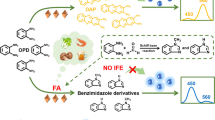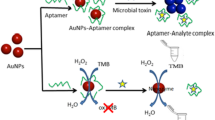Abstract
A biosensor for the determination of heavy metal cations based on glucose oxidase enzymatic inhibition has been developed. The biosensor was assembled on carbon film electrode supports with glucose oxidase immobilised by cross-linking with glutaraldehyde on top of a film of poly(neutral red) as redox mediator, prepared by electropolymerisation. The biosensor was used to determine the metallic cations, cadmium, copper, lead and zinc in the presence of chosen amounts of glucose. The detection limits were found to be 1 μg L−1 for cadmium, 6 μg L−1 for copper, 3 μg L−1 for lead and 9 μg L−1 for zinc. Inhibition constants were determined by using the Dixon plot, and the type of inhibition induced by the metallic cations was evaluated from Cornish-Bowden plots plus Dixon plots, it being found that the inhibition is reversible and competitive for cadmium, mixed for copper and lead and uncompetitive for zinc. Copper-inhibited glucose oxidase to a greater extent followed by cadmium, lead and zinc. Regeneration of the glucose oxidase response was studied by using Ethylene diamine tetracetic acid metal-chelating agent and the nonionic surfactant Triton X-100. The suitability of the biosensor for determination in foodstuffs or beverages which contain trace concentrations of metals was investigated by performing recovery tests in commercial milk samples.







Similar content being viewed by others
References
Mushtakova VM, Fornina VA, Rogovin VV (2005) Toxic effect of heavy metals on human blood neutrophils. Biol Bull 32:276
Duruibe JO, Ogwuegbu MOC, Egwurugwu JN (2007) Heavy metal pollution and human biotoxic effects. Int J Phys Sci 2:112
Saracoglu S, Divrikli U, Soylak M, Elci L, Dogan M (2003) Determination of trace elements of some textiles by atomic absorption spectrometry. J Trace Microprobe Technol 21:389
Buzica D, Gerboles M, Borowiak A, Trincherini P, Passarella R, Pedroni V (2006) Comparison of voltammetry and inductively coupled plasma-mass spectrometry for the determination of heavy metals in PM10 airbone particulate matter. Atmos Environ 40:4703
Dugo G, La Pera L, Pellicanó TM, Di Bella G, D’Imperio M (2005) Determination of some inorganic anions and heavy metals in D.O.C. Golden and Amber Marsala wines: statistical study of the influence of ageing period, colour and sugar content. Food Chem 91:355
Brett CMA (1999) Electroanalytical techniques for the future: the challenges of miniaturization and of real-time measurements. Electroanalysis 11:1013
Brainina KZ, Stozhko NY, Belysheva GM, Inzhevatova OV, Kolyadina LI, Cremisini C, Galletti M (2004) Determination of heavy metals in wines by anodic stripping voltammetry with thick-film modified electrode. Anal Chim Acta 514:227
Evtugyn GA, Budnikov HC, Nikolskaya EB (1998) Sensitivity and selectivity of electrochemical enzyme sensors for inhibition determination. Talanta 46:465
Bontidean I, Berggren C, Johansson G, Csoregi E, Mattiasson B, Lloyd JA, Jakeman KJ, Brown NL (1998) Detection of heavy metal ions at femtomolar levels using protein-based biosensors. Anal Chem 70:4162
Fennouh S, Casimiri V, Geloso-Meyer A, Burstein C (1998) Kinetic study of heavy metal salt effects on the activity of L-lactate dehydrogenase in solution or immobilized on an oxygen electrode. Biosens Bioelectron 13:903
Amine A, Cremisini C, Palleschi G (1995) Determination of mercury (II), methylmercury and ethylmercury in the ng/ml range with an electrochemical enzyme glucose probe. Microchim Acta 121:183
Gayet JC, Haouz A, Geloso-Meyer A, Burstein C (1993) Detection of heavy metal salts with biosensors built with an oxygen electrode coupled to various immobilized oxidases and dehydrogenases. Biosens Bioelectron 8:177
vel Krawczyk TK, Moszczynska M, Trojanowicz M (2000) Inhibitive determination of mercury and other metal ions by potentiometric urea biosensor. Biosens Bioelectron 15:681
Pirvutoiu S, Dey E, Bhand S, Ciucu A, Magearu V, Danielsson B (2002) Application of the enzyme thermistor for determination of mercury and other heavy metals using free and immobilised alcohol oxidase. Roum Biotechnol Lett 7:975
Toren EC, Burger FJ (1968) Trace determination of metal ion inhibitors of the glucose-glucose oxidase system. Microchim Acta 56:538
Karyakin AA, Karyakina EE, Schmidt HL (1999) Electropolymerized azines: a new group of electroactive polymers. Electroanalysis 11:149
Ghica ME, Brett CMA (2006) Development of novel glucose and pyruvate biosensors at poly(neutral red) modified carbon film electrodes. Application to natural samples. Electroanalysis 18:748
Pauliukaite R, Ghica ME, Barsan MM, Brett CMA (2007) Characterisation of poly(neutral red) modified carbon film electrodes; application as a redox mediator for biosensors. J Solid State Electrochem 11:899
Malitesta C, Guascito MR (2005) Heavy metal determination by biosensors based on enzyme immobilised by electropolymerisation. Biosens Bioelectron 20:1643
Brett CMA, Angnes L, Liess HD (2001) Carbon film resistors as electrodes: voltammetric properties and application in electroanalysis. Electroanalysis 13:765
Filipe OMS, Brett CMA (2004) Characterization of carbon film electrodes for electroanalysis by electrochemical impedance. Electroanalysis 16:994
Mohammadi H, Amine A, Cosnier S, Mousty C (2005) Mercury-enzyme inhibition assays with an amperometric sucrose biosensor based on a trienzymatic-clay matrix. Anal Chim Acta 543:143
Dixon M (1953) The determination of enzyme inhibitor constants. Biochem J 55:170
Rodriguez BB, Bolbot JA, TothillI E (2004) Development of urease and glutamic dehydrogenase amperometric assay for heavy metals screening in polluted samples. Biosens Bioelectron 19:1157
Cornish-Bowden A (1974) A simple graphical method for determining the inhibition constants of mixed, uncompetitive and non-competitive inhibitors. Biochem J 137:143
Amine A, Mohammadi H, Bourais I, Palleschi G (2006) Enzyme inhibition-based biosensors for food safety and environmental monitoring. Biosens Bioelectronm 21:1405
Gibbs PNB, Gore MG, Jordan PM (1985) Investigation of the effect of metal ions on the reactivity of thiol groups in human 5-aminolaevulinate dehydratase. Biochem J 225:573
Tandogan B, Ulusu NN (2006) Effects of cadmium and zinc ions on purified lamb kidney cortex glucose-6-phosphate dehydrogenase activity. J Enz Inhib Med Chem 21:225
Aiken AM, Peyton BM, Apel WA, Petersen JN (2003) Heavy metal-induced inhibition of Aspergillus Niger nitrate reductase: applications for rapid contaminant detection in aqueous samples. Anal Chim Acta 480:131
Nakamura S, Ogura Y (1968) Mode of inhibition of glucose oxidase by metal ions. J Biochem 64:439
Aceto M, Abollino O, Bruzzoniti MC, Mentasti E, Sarzanini C, Malandrino M (2002) Determination of metals in wine with atomic spectroscopy (flame-AAS, GF-AAS, and ICP-AES); a review. Food Addit Contam 19:126
Acknowledgements
Financial support from Fundação para Ciência e Tecnologia (FCT) Portugal, ICEMS (Research Unit 103) is gratefully acknowledged. M.E.G. thanks FCT for a PhD grant (SFRH/BD/14014/2003). Prof. H.-D. Liess is thanked for the gift of the electrical resistors.
Author information
Authors and Affiliations
Corresponding author
Rights and permissions
About this article
Cite this article
Ghica, M.E., Brett, C.M.A. Glucose oxidase inhibition in poly(neutral red) mediated enzyme biosensors for heavy metal determination. Microchim Acta 163, 185–193 (2008). https://doi.org/10.1007/s00604-008-0018-1
Received:
Accepted:
Published:
Issue Date:
DOI: https://doi.org/10.1007/s00604-008-0018-1




